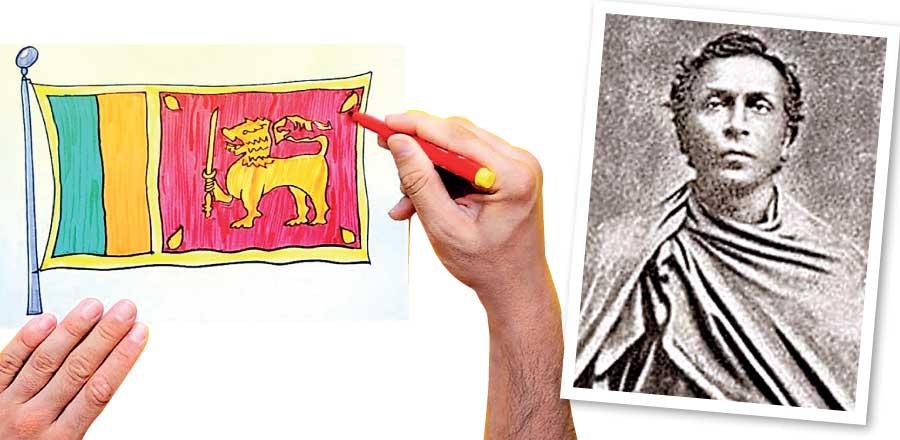Reply To:
Name - Reply Comment

Gunadasa Amarasekara’s first two novels, Karumakkarayo and Yali Upannemi, have long been out of print. I have been told that this has partly been due to Mr Amarasekara’s wishes, though I can’t quite confirm. In any case his renunciation, coming in after more than a decade of imbibing D. H. Lawrence, Andre Gide, and Arthur Miller, was followed by a leap of faith: with Aliya saha Andayo, Gandabba Apadanaya and Abuddassa Yugayak, he broke ranks with his contemporaries. 
Abuddassa Yugayak came out in 1976. It was followed four years later by Anagarika Dharmapala Marxvadiyek da, which he begins with an extensive critique of colonial era historical narratives taught and taken as the gospel truth by us. If his rejection of G. C. Mendis’s reading of 1956 there marked a break from conventional wisdom, his more important thesis, that Bandaranaike continued the struggle spearheaded by Dharmapala, and failed, signalled an ideological rupture. Never before had an act of literary self-criticism here propelled an author so much on to the political stage.
Ajith Samaranayake called it “the crisis of the Sri Lankan intelligentsia”: the inability of the Westernised elite, who lacked “an historic sense”, to bring about much needed political, social, and economic changes after independence. In this the bourgeoisie were as much to blame as the Marxists, since both seemed to be cut off from the current of ordinary life in the country. This was, of course, Regi Siriwardena’s point also; the hero of Among My Souvenirs, through his friendship with the leftist Wije and the bourgeois idealist Mark, realises the futility of Marxism and liberalism, or rather the overwhelming belief of both in “the perfectibility of individuals”, and leaves. The solution to both had come in the form of a democratic, liberal leadership, but S. W. R. D. Bandaranaike, after successfully snatching the petty bourgeoisie from the UNP, along with the monk, indigenous physician, teacher, cultivator, and worker, was forced to kowtow to populism, promising Sinhala in 24 hours and establishing a Cultural Affairs Ministry rooted more, as Samaranayake astutely noted, in the past than in the future. That we came to be stuck in a rut was only to be expected.
"The Jathika Chinthanaya was born from these forces. Despite Amarasekara’s resistance to the educated petty bourgeoisie and Nalin’s opposition to Marxism, both were products of milieus they were fighting with; both had, for a brief period, flirted with the ideologies they were critiquing"
But if the Marxists and the Westernised elite were wrong, the bilingual educated were no less so. Here Samaranayake traced, as best as he could, the contours of Amarasekara’s thinking, inferring in the man’s disappointment at the “dominantly Sinhala educated” the failure of the educated Sinhala undergraduate, hailing from the rural backwaters of the country, to secure a future and to satisfy his aspirations. If there is one strand in Amarasekara’s thinking that has remained and endured to date, it is his abiding belief in the rural peasantry’s leadership over the country’s destiny. But the rural peasantry, emancipated after 1956, thought they could have the cake and eat it (or eat the cake and have it). The reality could not have been more different: they got the cake, they ate it, but those who handed it over were the same elites they had been trying to get out. This contradiction between the illusion and reality, coupled with the democratisation of the civil service, school, and university, led to a massive influx of the rural petty bourgeoisie. Their feet were in both worlds, but they were not at home in either. The old elites, moreover, hadn’t budged. The result was an insurrection.
This was the paradox at the heart of 1956: it couldn’t have happened without the underclass, but at the same time the underclass had to be mobilised by the Sinhala speaking middle class. Amarasekara himself was of that middle class; he is, today, the last bilingual writer from his generation. It is a generation that will never return, because the forces which gave birth to it were contradicted by the democratisation of public institutions that it facilitated. It could not, in other words, survive free universal education; it languished soon after.
Amarasekara, and with him Nalin de Silva, were thus products of this milieu. Amarasekara’s disappointment with it must be seen in the context of his time. And his later absconding from the beliefs of his youth must be seen as a prelude to his foray into the most misunderstood movement this country has ever produced. If the Jathika Chinthanaya can be condemned as not having gone far enough, it is because its founders never intended to take it that far. Fundamentally, it was rooted in the past. To say that this undid it, however, is to understate the enormous influence it wielded, even if its articulators were in a different camp.
 The Jathika Chinthanaya was partly based on a critique of the Marxist movement by Nalin de Silva. It was not, as Dr. Dayan Jayatilleka pointed out, really original: “it was an old critique pioneered by people like Philip Gunawardena... that the main flaw of the left was that it ignored Sinhala traditions and culture and indeed that it was alien and hostile to those traditions and that culture.” But here too, context is key: in 1956 when Philip Gunawardena threw his weight behind S. W. R. D. and in 1965 when he did the same with Dudley, the left had succumbed to the temptations of compromise: it had caved into the demands of the petty bourgeoisie and its harbinger, the SLFP, something it would openly criticise in the seventies. When Nalin de Silva presented his argument, in contrast, the Old Left was entering a new phase, where it was to give in to the conundrum of supporting the Indo-Lanka Accord while opposing an administration led by the traditional enemy, the UNP. To add to their dilemma, sections of the petty bourgeoisie in the SLFP had now crossed over to the UNP. Firebrands like Cyril Matthew were products of this transformation.
The Jathika Chinthanaya was partly based on a critique of the Marxist movement by Nalin de Silva. It was not, as Dr. Dayan Jayatilleka pointed out, really original: “it was an old critique pioneered by people like Philip Gunawardena... that the main flaw of the left was that it ignored Sinhala traditions and culture and indeed that it was alien and hostile to those traditions and that culture.” But here too, context is key: in 1956 when Philip Gunawardena threw his weight behind S. W. R. D. and in 1965 when he did the same with Dudley, the left had succumbed to the temptations of compromise: it had caved into the demands of the petty bourgeoisie and its harbinger, the SLFP, something it would openly criticise in the seventies. When Nalin de Silva presented his argument, in contrast, the Old Left was entering a new phase, where it was to give in to the conundrum of supporting the Indo-Lanka Accord while opposing an administration led by the traditional enemy, the UNP. To add to their dilemma, sections of the petty bourgeoisie in the SLFP had now crossed over to the UNP. Firebrands like Cyril Matthew were products of this transformation.
It was an era of fluidity, of ethnicity transcending political ideology. There were chauvinists in the SLFP and UNP, and there were those opposed to chauvinism (who embraced the other, as fundamentalist readings of the national question) on the left. This, of course, proves the contention that chauvinism is largely petty bourgeois (SLFP or UNP), but it also impacted the left: in a period where ethnicity transcended everything else, it jettisoned the class character of the conflict in favour of the ethnic character. The old left succumbed to such a reading because, to be fair by them, they had no other route to take: a neo-fascist regime in power, cracking down on dissidents in the North and the South, had been caught in a cul-de-sac in the North by the neighbour across the Palk Straits. India was hence seen by the left as a saviour. The JVP, of course, had another route: it vilified India as Valmiki’s Rama taking revenge on Ravana; a Pawana song by Nanda Malini, penned by Sunil Ariyaratne, referred to Indians as “hota bariyo” (pigs). The insurrection all this led to was bloodier than the first.
"Ajith Samaranayake called it “the crisis of the Sri Lankan intelligentsia”: the inability of the Westernised elite, who lacked “an historic sense”, to bring about much needed political, social, and economic changes after independence"
The Jathika Chinthanaya was born from these forces. Despite Amarasekara’s resistance to the educated petty bourgeoisie and Nalin’s opposition to Marxism, both were products of milieus they were fighting with; both had, for a brief period, flirted with the ideologies they were critiquing. Meanwhile, the new petty bourgeoisie, emancipated in 1956, had abandoned the village and moved “into posh addresses in Colombo, which they had got as part of their dowries” as Samaranayake observed; it was not through them that Amarasekara and Nalin intended to spread their gospel. And in coming up with an alternative to the SLFP, the UNP, and the Old Left, they had consciously, at the same time, tried to avoid the path of the New Left. The similarities between the two outfits were not obvious, but they were there; Liyanage Amarakeerthi was not wrong when he once wrote that “a student of medicine from Lumumba University... and a dentist from the University of Ceylon... were two of the most significant people trying to cure [the] social maladies of Sinhala society.”
But – and it is here, and not in the unoriginality of Nalin’s critique of Marxism, where we can squarely criticise the Jathika Chinthanaya School – while they refused to be taken over by the right wing of the SLFP and UNP that had facilitated the transition from the one to the other, they were captured by these very same forces. One can sense in both Amarasekara’s and, to a more discernible extent, Nalin’s resistance to the new generation of the Sinhala Buddhist right, which found its most articulate voice, for a brief period, with Champika Ranawaka, an unwillingness to let go of the monopoly they’d exerted over the movement.
Their opposition to S. L. Gunasekara must also be seen in this light, though that rift was less marked than the one between them and the Hela Urumaya. In any case, in bringing the gospel of national consciousness to the country, they had enmeshed it in the city, not village. The irony was that, despite this, it continued to be nurtured in the village. The transition from the one to the other, which I’ve examined before in this paper, would be brought about, not by the old guard, but by the Young Turks: the Hela Urumaya. And the man who would take it back to the village, back to the Deep South, happened to be Mahinda Rajapaksa.